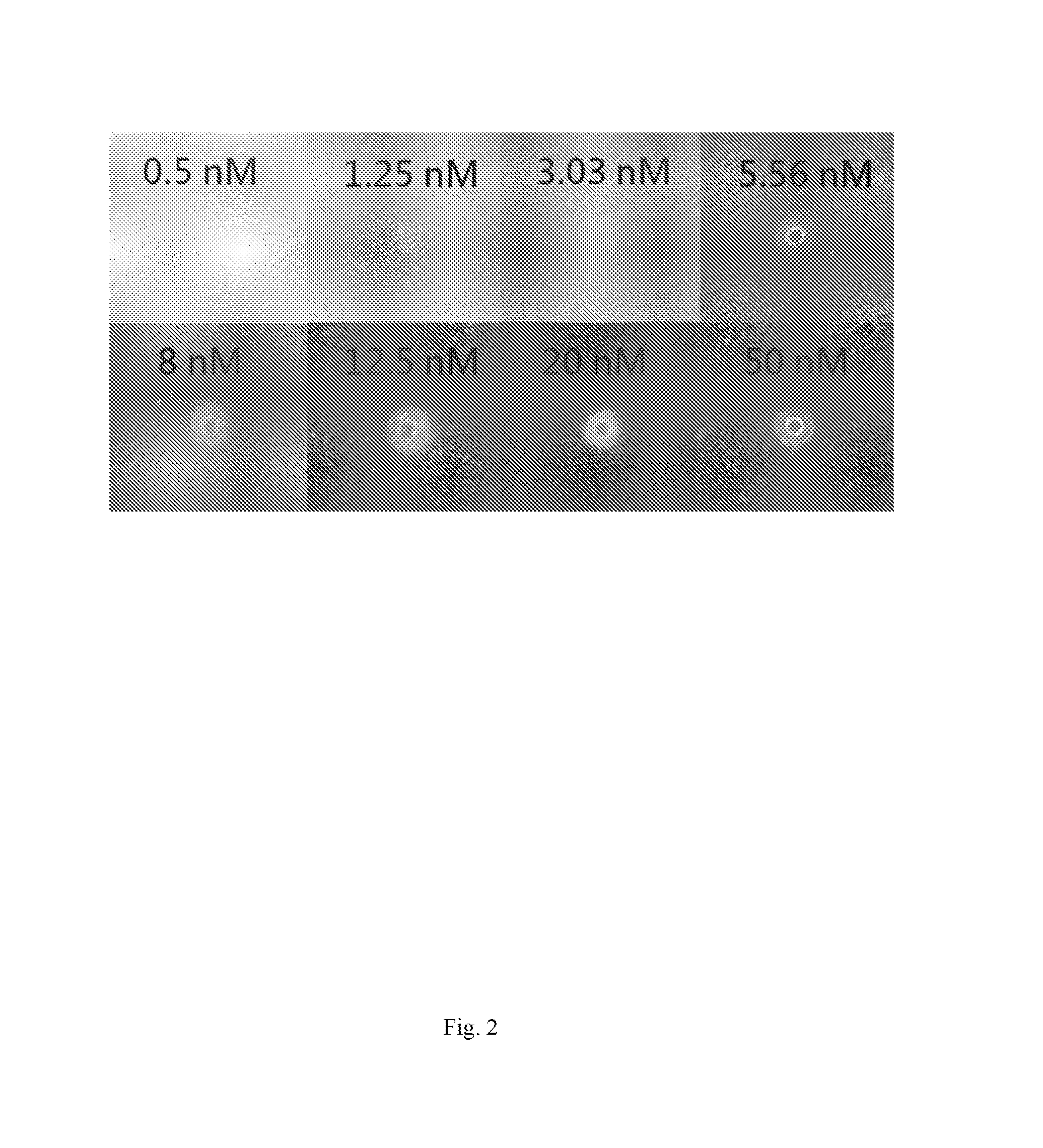Method for analyzing molecule using thermophoresis
a technology of thermophoresis and molecule, which is applied in the direction of material analysis, biochemistry apparatus and processes, instruments, etc., can solve the problems of difficult to measure the concentration of molecules based on thermophoretic motion of molecules, and achieve the effect of improving the accuracy of molecule detection and reducing the variability of thermophoretic mobility
- Summary
- Abstract
- Description
- Claims
- Application Information
AI Technical Summary
Benefits of technology
Problems solved by technology
Method used
Image
Examples
example
Example 1
Preparation of Samples for the Detection of DNA (Sandwich Method)
[0075]20 nm of gold nanoparticles were mixed with thiol-modified DNA (DNA—1) in the ratio 1:1,000 in 10 mM of phosphate buffer containing 0.5 M NaCl. The concentration of the gold nanoparticles was 1.2 nM. DNA—1 molecules were bound to the surface of the gold nanoparticles through thiol group. The unbound DNA—1 molecules were removed by certification, and the gold nanoparticle solution was concentrated to reach a concentration of 2.3 nM.
[0076]50 μl of the resulting solution was mixed with 1 μl of FITC-modified DNA (DNA—2, 1 μM) in room temperature. After mixing, the concentration of DNA—2 was 19.6 nM.
[0077]Several known concentrations of DNA (DNA—3) solutions were prepared to obtain a calibration curve for DNA quantification. The DNA—3 was diluted with fetal bovine serum (FBS) to reach final concentrations ranging from 0.5 nM to 50 nM (1 μl of the stock solution were diluted 20, 50, 80, 125, 180, 330, 800, and...
example 2
Detection of Molecules Using Thermophoresis
[0080]A cover slip coated with a thin chromium layer (40 nm) was prepared, and two pieces of double-sided tape was attached to the surface of the chromium layer. The distance between the two pieces of double-sided tape was about 2 mm. An uncoated cover slip was put on the top of the chromium layer and the double-sided tape to form a microchamber between the two cover slips. The microchamber could accommodate an aqueous sample that has a volume of about 3 μl. The sample was injected into the microchamber for analysis.
[0081]A temperature gradient was provided by near infrared laser light (Nd:YAG, 1064 nm, power was 8 mW before an objective lens) focused on the chromium layer using a 20× objective lens with N.A. 0.45. The temperature of the solution at the focal point was increased to 31° C. After laser exposure, the fluorescent DNA (DNA—2) was not uniformly distributed around the heated region because of thermophoresis. Fluorescence was obser...
example 3
Preparation of Samples for the Detection of Proteins (Competition Method)
[0084]40-nm gold nanoparticles were mixed with thiol-modified DNA (DNA—1) in the ratio 1:400 in 1× phosphate buffered saline (PBS). After mixing, the concentration of the gold nanoparticles was 0.3 nM, and the concentration of DNA—1 was 119.2 nM. DNA—1 molecules were bound to the surface of the gold nanoparticles through thiol group.
[0085]The unbound DNA—1 molecules were removed by certification, and the gold nanoparticle solution was concentrated to reach a concentration of 0.6 nM.
[0086]Interferon-γ (IFN-γ) aptamers were used as the probes (DNA—3) for the detection of IFN-γ. After mixing 1 μl of 10 μM DNA—3, 1 μl of 10 μM FITC modified DNA (DNA—2), and 8 μl of 1×PBS, the concentration of DNA—2 and DNA—3 was 1 μM.
[0087]Several known concentrations of IFN-γ solutions were prepared to obtain a calibration curve for IFN-γ quantification. The IFN-γ was diluted with 1×PBS to reach final concentrations ranging from 0...
PUM
| Property | Measurement | Unit |
|---|---|---|
| size | aaaaa | aaaaa |
| size | aaaaa | aaaaa |
| size | aaaaa | aaaaa |
Abstract
Description
Claims
Application Information
 Login to View More
Login to View More - R&D
- Intellectual Property
- Life Sciences
- Materials
- Tech Scout
- Unparalleled Data Quality
- Higher Quality Content
- 60% Fewer Hallucinations
Browse by: Latest US Patents, China's latest patents, Technical Efficacy Thesaurus, Application Domain, Technology Topic, Popular Technical Reports.
© 2025 PatSnap. All rights reserved.Legal|Privacy policy|Modern Slavery Act Transparency Statement|Sitemap|About US| Contact US: help@patsnap.com



